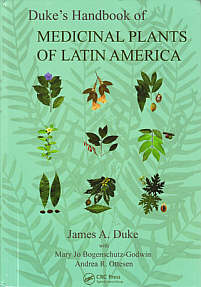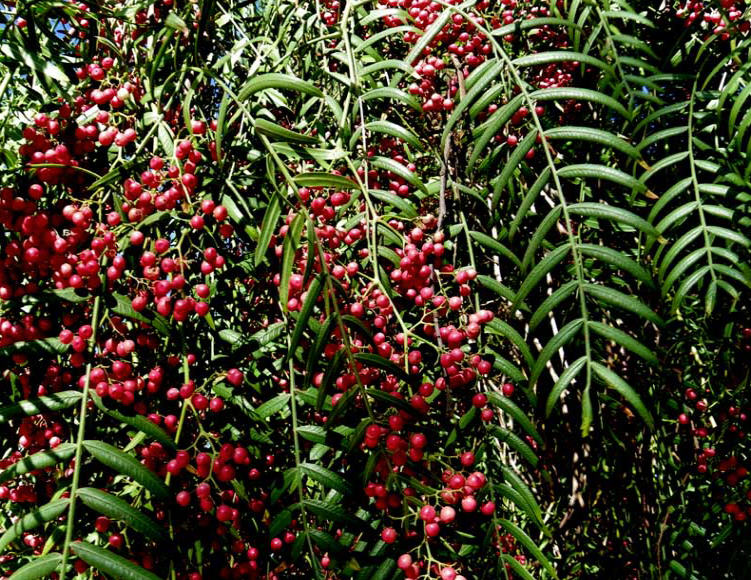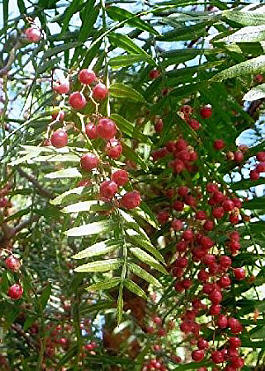|
Colds, Flus, Respiratory Infections
Menstrual Irregularies and Disorders
Brazilian
Peppertree

Brazilian Peppertree
(Schinus molle)
Code BOS222
Price: $15.50
120 Capsules x 500 mg.
Order Now
 Email
Email
 Summarized Description: Summarized Description:
Brazilian Peppertree, which is also known as Peruvian Pepper Tree, Peppercorn Tree, Californian Pepper Tree, among
many other common names, is actually native to the Peruvian Andes. It is unrelated to
true pepper (Piper nigrum). Some confusion has been created with the common
names because Schinus molle is not the same as Schinus terebinthifolius
which has also been called Brazilian Peppertree. For the rest of this article,
we will abbreviate as "BP Tree."
 All parts of this tree are used by various
indigenous groups ethnobotanically. Primary uses include the treatment of colds, flu,
upper respiratory infections, for fungal infections such as Candida, hypertension
remedy, and as a female balancing aid for menstrual disorders, such as excessive bleeding
and menstrual cramps.
Uses & Protocols
 All parts of this tree are used by various
indigenous groups ethnobotanically. Primary uses include the treatment of colds, flu,
upper respiratory infections, for fungal infections such as Candida, hypertension
remedy, and as a female balancing aid for menstrual disorders, such as excessive bleeding
and menstrual cramps. Dosage: one capsules, twice daily.
Warnings & Contraindications
 Do not use if pregnant or lactating. Avoid
if suffering from obstructive urinary stones, nephrosis, or edema due to impaired heart.
Shelf-Life
 Five years or more.

Medicinal Activities
 Further information for practitioners: Further information for practitioners:
World-famous botanist Dr. James Duke attributes the following activities
to this plant (p. 517-519; see hardcopy cover at right,
purchasable on Amazon),
drawn from the extant literature. (See his graduation for "level of
efficacy" on our amazon traditionals page;
followed by Duke's bibliographic abbreviations (in capital letters),
which we identify
on a separate page.)
 Duke provides a " food farmacy potential" score for this
plant of "FNFF=!."
- Acaricide (1; X16022288)
- Acarifuge (1; X16022288)
- Allergenic (1; MPG)
- Analgesic (f; EGG)
- Anesthetic (f; GAZ)
- Antiedemic (1; X14648390)
- Antiinflammatory (f1; PH2; X14648390)
- Antiviral (f; CRC)
- Astringent (1; CRC ; PH2)
- Bactericide (1; X8055554)
- Bitter (1; PH2)
- Candidicide (1; X15619579)
- Cicatrizant (f; EGG)
- Collyrium (f; CRC)
- Cytotoxic (1; MPG; X14648390; X11849838)
- Depurative (f; EGG)
- Diuretic (f; CRC; DLZ; EFS; GAZ; PH2)
- Emmenagogue (f1; CRC; MPG; WOI)
- Expectorant (f; EFS; ROE)
- Fungicide (1; PH2)
- Hemostat (f; EGG)
- Hypotensive (f1; EGG; MPG)
- Orexigenic (f; GAZ)
- Pain (f; EGG)
- Piscicide (f; CRC)
- Poison (1; MPG)
- Purgative (f1; CRC; EFS; MAX; PH2)
- Stomachic (f; CRC; EFS; PH2)
- Tonic (f; CRC; EFS)
- Vulnerary (f; CRC; PCS; PH2; ROE)
Indications
 Further information for practitioners: Further information for practitioners:
Duke provides the following indications for this plant:
- Adenopathy (f; MPB)
- Amenorrhea (f1; CRC; MPG; WOI)
- Anorexia (f; GAZ; PH2)
- Anuria (f; PH2)
- Aphtha (f; RAI)
- Aposteme (f; CRC)
- Arthrosis (f; PH2)
- Bacillus (1; X8055554)
- Bacteria (1; X8055554)
- Bleeding (f; EGG; MPB; ROE)
- Blennorraghia (f; CRC; MPB; PH2; ROE)
- Bronchosis (f; CRC; GAZ; JTR; PCS)
- Bubo (f; MPB)
- Burns (f; ROE)
- Cancer (f1; JLH; X11849838)
- Cancer, foot (f; JLH)
- Cancer, liver (f1; JLH; X11849838)
- Candida (1; X15619579)
- Carcinoma (1; X11849838)
- Caries (f; ROE)
- Cataracts (f; CRC; JTR; MAX; ROE)
- Catarrh (f; ROE)
- Childbirth (f; ROE)
- Colds (f; PH2; ROE)
- Colic (f; MPG)
- Conjuctivosis (f; PH2; ROE)
- Constipation (f; GAZ)
- Cornea (f; MAX)
- Coughs (f; DLZ; GAZ; ROE)
- Cramps (f; MPB; ROE)
- Cystosis (f; GAZ)
- Dermatosis (f; PH2; ROE)
- Diarrhea (f; CRC; ROE)
- Dropsy (f; EGG)
- Dysentery (f; MPB; ROE)
- Dysmenorrhea (f; CRC; MPG)
- Dyspepsia (f; GAZ; JTR)
- Dysuria (f; HH2)
- Edema (f1; MPG; X14648390)
- Escherichia (1; X8055554)
- Fracture (f; ROE)
- Fungus (1; X15619579)
- Gastrosis (f; PH2)
- Gingivosis (f; CRC; EFS; MAX; WOI)
- Gonorrhea (f; CRC; JTR; MAX; MPB; ROE)
- Gout (f; CRC; WOI)
- Headache (f; EGG)
- Hemoptysis (f; CRC)
- Hepatosis (f1; EGG; X11849838)
- High Blood Pressure (f1; EGG; MPG; PH2; ROE)
- Hoarsness (f; DLZ)
- Infection (1; PH2; X15619579)
- Inflammation (f1; MPG; PH2; X14648390)
- Ischia (f; HH2)
- Klebsiella (1; X8055554)
- Leukorrhea (f; EGG; MPB; PH2)
- Mucososis (1; PH2)
- Myalgia (f; PH2)
- Mycosis (1; MPG; X15619579)
- Nausea (f; PH2; ROE)
- Neuralgia (f; GAZ)
- Odontosis (f; PH2)
- Oliguria (f; MAX)
- Ophthalmia (f; CRC; MPB)
- Orchosis (f; MPB)
- Pain (f; DLZ; PH2)
- Parasites (1; MPG)
- Pharyngosis (f; HH2; PH2)
- Pneumonia (f; ROE)
- Prolapse (f; CRC; PH2; ROE)
- Pseudomonas (1; MPG)
- Puerperium (f; ROE)
- Pyorrhea (f; DLZ; MPG)
- Respirosis (f; EGG; PH2)
- Rheumatism (f; CRC; EGG; MPB; PH2; ROE)
- Sciatica (f; GAZ)
- Serratia (1; X8055554)
- Sores (f; CRC; HH2; MPG)
- Sore Throat (f; EGG; PH2; ROE)
- Spasms (f; EGG)
- Sprains (f; ROE)
- Staphylococcus (1; MPG)
- Stomatosis (f; MAX)
- Swelling (f; CRC; PCS; PH2; ROE)
- Toothache (f; DLZ; EGG)
- Tuberculosis (f; CRC; HH2; MPG)
- Tumors (f; JLH)
- Ulcers (f; CRC)
- Urethrosis (f; CRC; GAZ; HH2)
- Urogenitosis (f; CRC; HH2; MAX)
- Uterosis (f; CRC; PH2; ROE)
- Vaginosis (f; GAZ)
- VD (f; CRC; WOI)
- Vomiting (f; PH2)
- Warts (f; JLH)
- Water Retention (f; HH2)
- Worms (f; ROE)
- Wounds (f; CRC; PH2)
- Yeast (1; X15619579)
|
 To U.S. Users: To U.S. Users: This product
have not been evaluated by the U.S. Food & Drug Administration.
It is not intended to diagnose, treat, cure, or prevent any disease.
|
 Recent Studies on BP Tree
Recent Studies on BP Tree
Sourced from PubMed
 Disclaimer: Disclaimer: The following citations provide findings on the
properties of Brazilian Peppertree and offer insights into prospective areas of future research.
These findings should not be inferred to provide the basis of medicinal claims,
nor should they be relied upon by the public, as such. Readers who want full access to
the PubMed database are encouraged to
register with NCBI.
 As of Jan. 2017, there were
51 citations on PubMed for Brazilian Peppertree. Below are list a few of the more notable:

-
Chemical compositions and antimicrobial and antioxidant activities of the essential oils from Magnolia grandiflora,
Chrysactinia mexicana, and Schinus molle found in northeast Mexico. (2013)
[ABSTRACT: . . . The oils from S. molle and M. grandiflora leaves had antimicrobial activity against Staphylococcus aureus
and Streptococcus pyogenes, which cause skin infections that potentially may lead to sepsis.]
-
Synergistic antibacterial activity of the essential oil of aguaribay (Schinus molle L.). (2012)
[ABSTRACT:
Schinus molle L. (aguaribay, aroeira-falsa, "molle", family Anacardiaceae), a native of South America, produces an active antibacterial
essential oil extracted from the leaves and fruits. This work reports a complete study of its chemical composition and determines the
antibacterial activity of Schinus molle L. essential oil and its main components. The results showed that the crude extract essential oil
has a potent antibacterial effect on Staphylococcus aureus ATCC 25923, a strong/moderate effect on Escherichia coli ATCC 25922 and moderate/weak
one on Pseudomonas aeruginosa ATCC 27853.]
-
Chemical composition and anticancer and antioxidant activities of Schinus molle L. and Schinus terebinthifolius Raddi berries essential oils.
(2010) [ABSTRACT: Essential oils were obtained by steam distillation from berries of Schinus molle L. and Schinus terebinthifolius Raddi
originating from southern of Tunisia and analyzed by GC-FID and GC-MS. Among 57 and 62 compounds (%[mg/100 g dry matter]) identified in these oils,
the main were alpha-phellandrene (46.52%[1256.15] and 34.38%[859.60]), beta-phellandrene (20.81%[561.74] and 10.61%[265.15]), alpha-terpineol
(8.38%[226.26] and 5.60%[140.03]), alpha-pinene (4.34%[117.29] and 6.49%[162.25]), beta-pinene (4.96%[133.81] and 3.09%[77.30]) and p-cymene
(2.49%[67.28] and 7.34%[183.40]), respectively. A marked quantity of gamma-cadinene (18.04%[451.05]) was also identified in the S. terebinthifolius
essential oil whereas only traces (0.07%[1.81]) were detected in the essential oil of S. molle. The in vitro antioxidant and antiradical scavenging
properties of the investigated essential oils were evaluated by using 1,1-diphenyl-2-picrylhydrazyl (DPPH) and 2,2'-Azinobis
(3-ethylbenzothiazoline-6-sulfonic acid) (ABTS) assays. Essential oil of S. terebinthifolius expressed stronger antioxidant activity in the
ABTS assay, with an IC(50) of 24 +/- 0.8 mg/L, compared to S. molle (IC(50)= 257 +/- 10.3 mg/L). Essential oils were also evaluated for their
anticancer activities against human breast cancer cells (MCF-7). S. terebinthifolius essential oil was more effective against tested cell
lines (IC(50)= 47 +/- 9 mg/L) than that from S. molle (IC(50)= 54 +/- 10 mg/L). Suggestions on relationships between chemical composition and
biological activities are outlined.]
-
Chemical composition of Schinus molle essential oil and its cytotoxic activity on tumour cell lines.
(2008) [ABSTRACT: The leaf essential oil hydrodistilled from Schinus molle grown in Costa Rica was characterised in terms of its
chemical composition, antioxidant activity, ability to induce cytotoxicity and the mechanism of cell death involved in the process. As a result,
42 constituents, accounting for 97.2% of the total oil, were identified. The major constituents of the oil were beta-pinene and alpha-pinene.
The antioxidant activity showed an IC(50) of 36.3 microg mL(-1). The essential oil was cytotoxic in several cell lines, showing that it is more
effective on breast carcinoma and leukemic cell lines. The LD(50) for cytotoxicity at 48 h in K562 corresponded to 78.7 microg mL(-1), which was
very similar to the LD(50) obtained when apoptosis was measured. The essential oil did not induce significant necrosis up to 200 microg mL(-1),
which together with the former results indicate that apoptosis is the main mechanism of toxicity induced by S. molle essential oil in this cell
line. In conclusion, the essential oil tested was weak antioxidant and induced cytotoxicity in different cell types by a mechanism related to
apoptosis. It would be interesting to elucidate the role that different components of the oil play in the effect observed here, since some of them
could have potential anti-tumoural effects, either alone or in combination.]

 Extensive information about
Brazilian Peppertree is covered on the Raintree Forest website.
Even better, you can purchase Leslie Taylor's excellent reference book,
The Healing Power
of Rainforest Herbs: A Guide to Understanding and Using Herbal Medicinals at Amazon.
 See Wikipedia article on
Brazilian Peppertree.
|


 Recent Studies on BP Tree
Recent Studies on BP Tree

